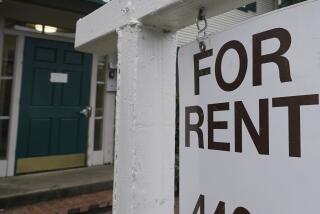Document move-in conditions to save deposit later
- Share via
Question: I’m planning to move into a new place next week, and the landlord is taking a hefty deposit. Any suggestions on getting it back when it’s time to move out?
Answer: Deposits are always a concern for renters, and the higher the rent, the higher the bar. So it’s important to know what to do before, during and at the close of the tenancy to ensure your money will be returned.
Before taking possession of your unit, complete a walk-through of the property -- preferably while the unit is still vacant. Use this time to take an inventory of the rental and ascertain its condition. An excellent checklist is available at dca.ca.gov/publications/landlordbook/index.shtml by selecting “inventory checklist” from the menu. This California Department of Consumer Affairs site offers other renter advice as well.
When filling out the inventory checklist, bring along blank paper and a clipboard, tape measure and camera to detail the items listed. Besides documenting conditions, it’s good to record the size of any damage: for example, a chip in the bathtub enamel. Ask the landlord what items are new or redone in the unit, especially flooring, paint and fixtures. New appliances should be noted on the sheet too.
Also crucial to protecting one’s investment is understanding the top deductions and how to avoid them. Although cleaning fees are common, there are large expenses of which to be wary.
Biggest deduction winners? Jim Silton, a property manager who handles about 400 properties in Los Angeles, said in his experience it’s carpeting. When inventorying, it’s important to do more than just “check the box,” since a single bleach stain or worn carpet could cost you hundreds or even thousands of dollars. If it looks like new carpeting, ask. If it’s not new, note the existing condition.
Other types of flooring, such as hardwood, tile and linoleum, also should be scrutinized. Because flooring covers a large area and cannot always be matched, replacement could eat up a deposit.
Another ding to avoid? Painting. Costs have grown over the years, especially with the higher expense of lead-free paint and materials. Once again, a single stain or large nail hole may signal the need for a wall or entire room to be painted. If you’re moving in and there are preexisting nail holes, stains or markings, a photo alone may not do it justice. Draw a simple sketch of the room’s floor plan and indicate with an X the damage location and type to correspond to the photo. A few moments could save you a bucket of cash.
Appliances can be expensive to fix or repair and should not be on your tab if they were dented, chipped or broken when you arrived. Since it’s impossible to run every appliance at move-in, note if there’s a problem when used. If the dishwasher leaks all over the floor, reporting it promptly in writing to the landlord can keep you from getting soaked.
Mold and mildew: Look under the sink and around water sources for discoloration. If the place had water leaks that caused mold to form, that’s not your fault. During your tenancy, report leaks promptly before damage is done.
Countertops and sinks: Look for chips, stains and discoloration, especially around the edges and faucet.
Some properties may include one-of-a-kind features such as chandeliers, bookcases or custom materials, that need special care. Rather than quibble over their condition or value, ask the landlord to detail these hard-to-define items.
Once your checklist has been meticulously completed and, you hope, approved by the manager or landlord, be sure to file the document with your rental paperwork.
A few weeks before move-out, you can dust off the list and do an “after” evaluation. In California, landlords are compelled by law to offer a walk-through a few weeks before move-out. Wherever you live, your finely tuned checklist should help keep the landlord and you on the same page regarding your deposit.
--
Reader comments may be sent to hmayspitz@gmail.com.
More to Read
Inside the business of entertainment
The Wide Shot brings you news, analysis and insights on everything from streaming wars to production — and what it all means for the future.
You may occasionally receive promotional content from the Los Angeles Times.










